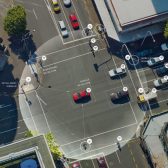How Boston plans to save $1 million by watching its power bill

Babysitting the thermostat and paying utility bills are usually considered domestic pastimes, but city hall does it too. The City of Boston pays about 3,000 utility bills each month that total more than $40 million each year. But thanks to some recent technological ingenuity, the city now estimates it will save between $700,000 and $900,000 annually on overbilling, while a new analytics dashboard is changing human behavior and allowing the city’s largest buildings to use less energy.
The energy monitoring tool is allowing officials like city energy manager Adam Jacobs, who led the project’s development, to use real-time measurements to guide his decisions and recommendations for energy operations. A close look at the charts below reveals how the tool is already saving the city thousands.
The line on the top shows a real-time view of the energy usage of the Boston Public Library in Copley Square, while the line on the bottom is the building’s energy usage from the day prior. The lines take a similar shape each day, and most notably, there’s a dip every day between 10 a.m. and 1 p.m. That dip, said Jacobs, is worth up to $40,000 annually at this one building alone.
The origin of the $40,000 dip is that at peak hours, Boston’s utility companies charge at higher rates, so Jacobs worked with the superintendent of libraries and now every day at 10 a.m., the 930,000-square-foot facility reduces fan speeds and turns off lights in some private areas of the library.
“It doesn’t impact any of the occupants of the library and reducing those fan speeds doesn’t do anything to the temperature in all the different reading areas of the library,” Jacobs said. “It basically just allows them to reduce their energy usage, and in the summer, during really peak times, they get compensated by the [grid operator].”
The city had the ability to monitor this usage previously, but not remotely, Jacobs said, nor as easily.
“What I did not want to do was create systems that required our users to log in and to navigate their way to a portal,” Jacobs said. “I wanted it to be as foolproof as possible for a facility manager who needs an answer to a question right away and doesn’t have to go sit at their desk.”
Now anyone can view the power usage of the city’s two largest buildings — the other is City Hall — from anywhere and at any time. During a recent snowstorm in which all municipal buildings were shut down, Jacobs recalled checking the tool from his apartment to see how things were going.
“I checked my phone and saw Copley branch library doing what it does every day. It goes up to 1,400/1,500 kilowatts at 7 am and it was operating like it was open,” Jacobs said. “So I took a screenshot of it and I texted one of the building engineers and said, ‘Hey, are you guys open today?’ … By being offsite and having access to this information, he was able to make the adjustment so during a snowstorm they’re not running the building at full bore.”
Framing the problem
This newfound overview of energy usage started with a small mistake. Seeing the potential for huge energy and cost savings, Boston’s technology leaders published a bulky RFP in late 2015 for a new enterprise energy management system. They were looking for a single piece of software that would allow the city to audit its many energy bills and provide a simple dashboard for real-time energy monitoring. The mistake, they soon realized, was in treating two challenges like they were one.
The city received seven vendor responses that gave the city a wide-range of cost and capability options, Jacobs said, but none of them were the all-in-one solution they had imagined. Only an expensive and time-consuming custom purchase would have met the diverse requirements of the joint procurement filed by the city’s technology, auditing, and environment departments. With the help of chief information officer Jascha Franklin-Hodge and chief data officer Andrew Therriault, the challenge was divided into two parts — the city would hire a vendor for the bill verification portion, which they awarded in July 2016, and use its existing contract with Tableau, a business intelligence and data visualization software company, to internally develop an analytics monitoring and reporting system.
“We realized that asking for too much was going to get us a diluted product from whatever vendor we selected,” Jacobs said.
Not having the funds for what they initially wanted turned out to be a good thing, he said, because building the analytics reporting in-house allowed their staff to build transferable data skills.
Changing behavior with data
Through a $147,600 SourceOne contract, the city essentially gained a billing consultant that is approaching $1 million in savings annually.
Anyone who’s looked at a utility bill can see how complex it is — estimated billing, rate amendments and billing periods are further complicated at the city level by a wide range of energy types that include electricity, natural gas, water and fuel deliveries. Every street light utility box in Boston gets its own bill.
It’s a “really complicated” billing structure, Jacobs said, and the city accountants paying these bills don’t usually have the technical expertise to know when the city is being overcharged. Nor do they have the granularity of data needed to spot when something is amiss.
“The departments will see what their annual utility budget is but they rarely get to break down into the individual facility level,” he explained.
When an outlier is spotted, the city can begin troubleshooting the problem — old energy-inefficient equipment might prompt a discussion with the budget department.
The vendor helps the city sort through its bills and then track down any supporting documents needed to refute the charges.
As the city continues using the new tools and learning how to modify behavior, the new uses will emerge. Jacobs reports that while the city hosts dashboards for real-time monitoring of just two city buildings today, the long-term plan is to extend the technology to more buildings. The data collected by the dashboard will also be posted to the city’s open data portal within the next couple weeks, he reported.
Ultimately, the purpose of this data is to change human behavior, Franklin-Hodge told StateScoop. And while they’re encouraged by the project, changing human behavior, he said, “is proving much more difficult.”






